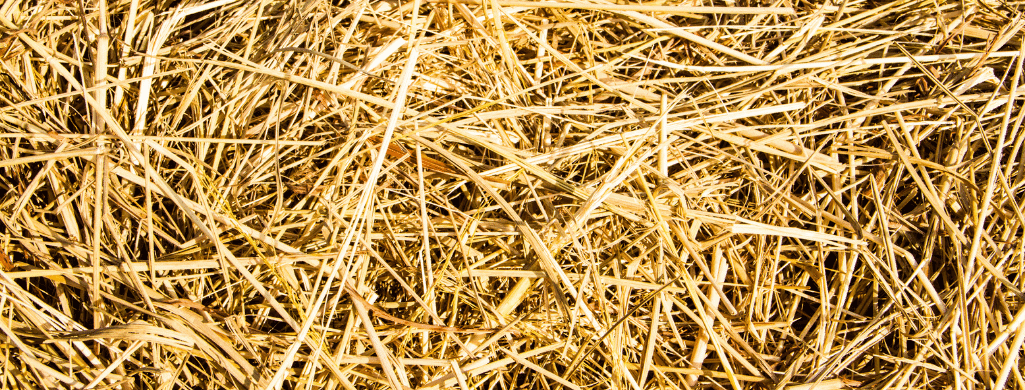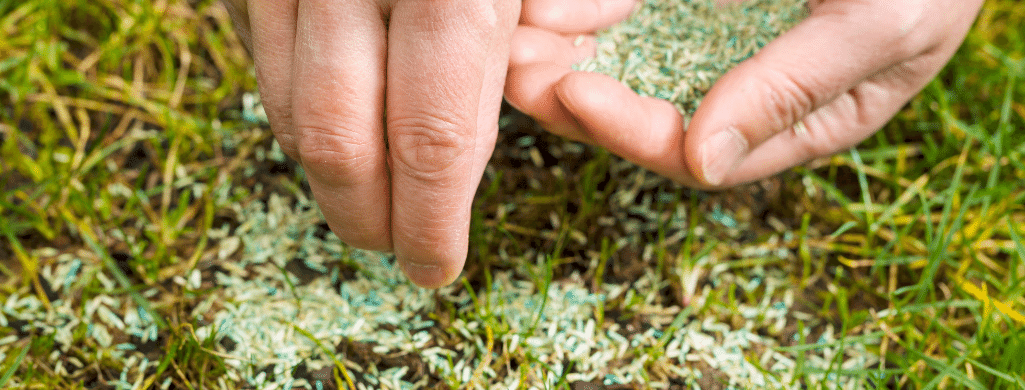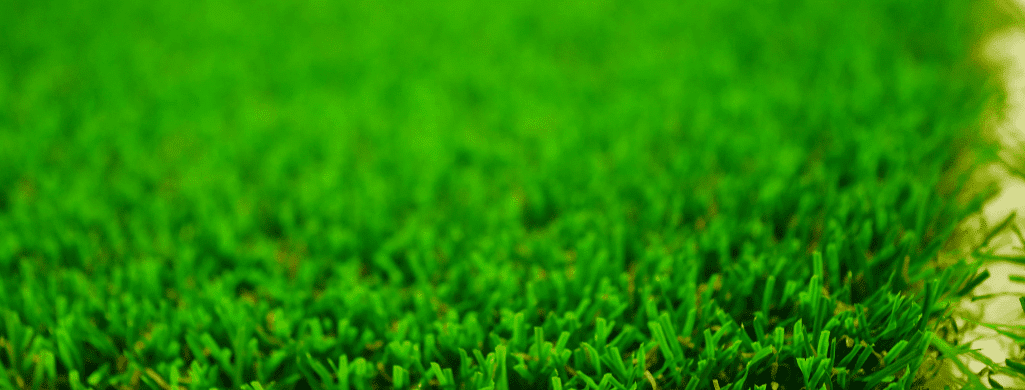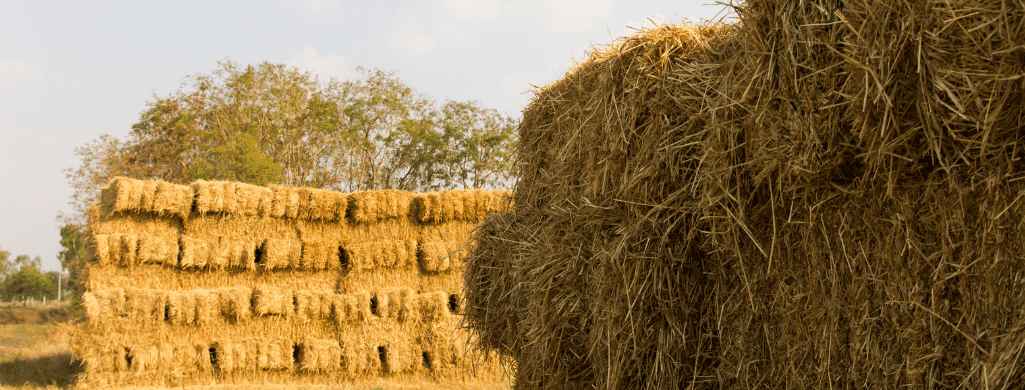Straw is used as a covering for newly-planted grass seeds to protect them from wind, rain, and hungry birds.
The protective layer of straw also retains heat and soil moisture, improving grass germination rates.
But how long do you leave straw on new grass?
Leave straw on new grass until after the initial mowing, when the grass is around 2-3” inches tall. New grass will take 6-8 weeks to reach mowing height, depending on weather conditions. If applied in a thin layer, most of the straw will decompose by this time.
Read on to learn about removing straw from new grass and alternative grass coverings to use.

Table of Contents
Why Do You Need Straw To Cover New Grass?
Before we get into removing straw from your new grass, it is important to understand why you would use it at all.
Grass will grow without covering it with straw, but the germination rate will be very low.
Exposed grass seedlings are blown by the wind or washed away with heavy rainfall.
Birds, moles, and chipmunks will view the seeds as a meal.
Excess sunlight dries out the soil and grass seeds, giving them little chance of growing.
Covering the grass seeds with a light layer of straw solves all these problems.
Remove existing weeds and use a starter fertilizer when planting grass seeds. This increases your chance of a healthy yard.
How Much Straw Do You Need?
Covering grass seedlings with straw provides a layer of protection against the elements. But, it is crucial to use the correct amount.
A heavier layer of straw will block out much-needed sunlight and smother the grass seeds.
Fungal growth will also thrive under a thick layer of straw due to the slow evaporation of water.
If you spread the straw too thin, the grass seeds will dry out from exposure to sunlight. There is also a risk they will be washed away by rain or eaten by wildlife.
The ground must be visible through the layer of straw to ensure the seeds get plenty of sunlight.
A quarter-inch layer of straw is all you need to cover new grass seed.
Straw is sold in bales and smaller bags in many home improvement and farm supply stores.
One bale of straw covers 1,000’ square feet of lawn. The smaller bags cover approximately 500’ square feet.
There are also miniature straw bales like this one, perfect for seeding only a small area on your lawn.
How Do You Remove Straw From Your Lawn?
When your new grass is long enough to mow, most of the straw will be decomposed, and removal is unnecessary.
It is best to allow the straw to decompose whenever possible.
However, if the straw is thick or clumped up in areas, you must remove it.
The easiest way to remove straw from new grass is to use a mower with a bagging attachment.
Be sure your grass is at least 2-3” inches tall so it has established a healthy root system.
Mowing your new grass too soon may pull it from the ground due to shallow roots.
Most of the straw and grass clippings will go into the bag, and nothing else needs to be done.
The straw may take a couple of mowing sessions to completely remove.
Another way to remove the excess straw from your new grass is to use a leaf rake.
You must be very gentle when raking up the straw to prevent damage to the new grass.

What To Do With Straw After Removing It
Once you have removed the straw from your lawn, it is not necessary to waste it.
Straw makes an excellent mulch for an established vegetable garden or flower bed.
Placing straw around your plants helps prevent weeds, retain soil moisture, and repel certain garden pests.
When straw decomposes, it releases nutrients into the soil for healthy plant growth.
Add straw to nitrogen-rich organic material like leaves and grass clippings for compost.
If you have straw left over after covering your new grass, you may use it as bedding for farm animals.
Nesting boxes, chicken coop floors, and rabbit hutches are excellent areas for straw.
Never use damp straw for animal bedding, as mold or other bacteria may form and make your animals sick.
Is Straw Better Than Hay for New Grass?
While straw and hay are often confused, there are notable differences between them.
Straw is made from grain stalks and does not contain seeds. It is yellow in color and very dry.
Hay comes from dried grass and legumes, including seed heads, leaves, and flowers. It is usually green and contains more moisture than straw.
Farmers typically use straw for animal bedding or mulch, while hay is fed to livestock.
Straw is the best option if you want to avoid weed seeds mixed in with your new grass.
Weed seeds compete with your grass for soil nutrients, moisture, and root space.
Another advantage of straw is its ability to dry faster than hay after getting wet. This feature makes it less likely to grow mold or other types of fungus.
Straw is also more budget-friendly since it is much cheaper to buy than hay.
What Kind of Straw Is To Use on New Grass?
Wheat straw covers new grass because it is inexpensive, easy to find, and less likely to contain seeds.
Barley or oat straws are sometimes used, but they are more expensive than wheat.
Aged pine straw is another good option to cover new grass.
Since pine straw is made from dried pine needles, it does not contain any seeds.
Never use fresh pine straw on your grass seedlings.
Fresh pine straw contains a chemical called terpene, which inhibits seed growth.
In aged pine straw, the terpene evaporates as the pine needles dry out.
One way to tell if your pine straw is well-aged is to smell it.
If the straw does not have the characteristic pine tree scent, it is safe to use on your new grass.

Alternative Coverings for New Grass
Straw is not the only option for covering newly-planted grass seeds.
The most common alternative coverings for new grass include:
- Sawdust
- Peat moss
- Compost
- Excelsior mats
- Coconut Coir
According to where you live, some of these alternatives may be easier to find than straw.
Each alternative has different benefits according to your climate and soil type.
Sawdust
Sawdust is excellent at retaining moisture and preventing compaction in heavy soils.
Apply sawdust in a quarter-inch layer, and ensure there are no clumps on your grass seeds.
If the sawdust is too thick, it will repel water and cause your seeds and soil to become dried out.
Sawdust will take nitrogen out of the soil, so it is best to pair it with a quality fertilizer.
Peat Moss
Peat moss does not add significant nutritional value to the soil. But it is suitable for covering new grass because of its ability to retain moisture.
Break up the peat moss clumps before applying them to your seeded area in a quarter-inch layer.
The best climate for peat moss has high humidity with low wind.
Check the weather forecast before applying peat moss. Heavy rain causes it to clump and wash away from sloped areas.
Peat moss will not prevent compacted soil but is a useful deterrent for birds.

Compost
Compost is one of the best alternatives to straw to cover newly-planted grass.
It is easy to create your own compost, and it contains high levels of essential nutrients.
Leaves, grass clippings, and chopped organic materials make an ideal compost for grass.
Avoid using compost or mulch with animal manure, as it may burn your new grass.
Ensure the compost is thoroughly decomposed to avoid attracting birds and other wildlife to your lawn.
Apply compost in a thin, quarter-inch layer after planting your grass seeds.
Excelsior Mats
Excelsior mats contain finely-shaved aspen wood fibers and are typically used to prevent soil erosion.
If you have sandy soil, excelsior mats are stabilizers and keep your grass seedlings in place.
Applying excelsior mats is easy, and they provide several essential nutrients.
Choose excelsior mats without any pesticides or other chemical treatments.
While pesticides may be helpful, not all of them are safe for use on different types of grass. Your seeds may not germinate properly with certain pesticides.
Coconut Coir Mats
Like sawdust and peat moss, coconut coir offers little nutritional value. But, it works well to aerate your soil and prevent erosion.
Coconut coir mats are used differently than other grass coverings.
Instead of applying the mats on top of grass seeds, they are placed on the ground before they are planted.
After watering the seeds, the coconut coir expands to form pockets in the soil. These air pockets allow the new grass to establish a strong root system.
While coconut coir mats like this one are expensive, they are worth it if soil erosion is a huge concern in your yard.
Coconut coir mats are long-lasting and do not need to be removed like straw.
The Final Straw
Taking proper lawn care does not have to be complicated or time-consuming.
Covering your newly-planted grass seeds will ensure healthy grass growth in the future.
Whether you are using miniature straw bales for a small area or an alternative like coconut coir mats over your entire lawn, there is a solution for every budget to meet your needs.
Check out these other ways to keep grass from washing away to learn more about protecting your new grass.